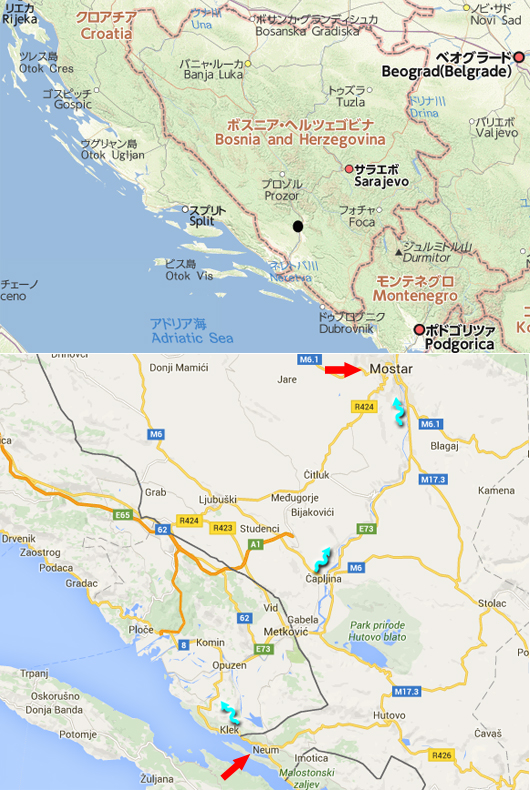クロアチア・スロベニアを巡って 24: 傷痕の町モスタル 3
< 1. I look at the old
city from a riverside restaurant of Neretva >
< 1.ネレトヴァ川沿いのレストランから旧市街を眺めた >
A sequel to the
introduction of Mostar
モスタル紹介の続きです
< 2. Views of Strai Most
(old bridge) from both sides >
< 2. 両側から見た石橋 >
Upper photo: A view from the yard of the mosque.
A large cross stands on
the top of the mountain.
Lower photo: A view from the riverside on the downstream
side.
A man just is going to
jump into the river from the top of the bridge.
Each time he gets money,
he jumps.
There is the jumping
event annually here.
上の写真: モスクの庭からの眺め。
山頂に大きな十字架が立っている。
下の写真: 下流側の川辺から。
橋の上の中央から男性が今にも飛び込もうとしている。
彼はお金を貰っては飛び込んでいる。
年一度、ここで飛び込みの大会があります。
< 3. Visit to “Turkish
house” in the old city >
< 3. 旧市街の「トルコの家」を訪ねて >
Upper photo: The minaret that we climbed can be seen.
Central photo: When we were badly bunkered as we don’t find
“Turkish house” at a map of a signboard, somebody called to us from behind and
taught the pathway to it.
This kind man is the
left side on the photo.
I think the map
indicated not “Turkish house” but “Ottoman house”.
Lower photo: “Turkish house”
When we arrived on it,
we looked at only the entrance and had to return because our free time just was
over.
上の写真: 私が登ったモスクのミナレットが見える。
中央の写真: 私達は看板の地図に「トルコの家」が見つからなくて困っていました。
すると後ろから声を掛けてくれる人がいて、道を教えてくれた。
その人が、写真左側の人でした。
看板には「トルコの家」ではなく「オットマン・ハウス」と表記されていたように思う。
下の写真: トルコの家。
辿り着いた時には戻る時間になっていて入口を覗くだけで引き返した。
We left Mostar and went
to the next stage.
モスタルを出て、次の宿泊地に向かう。
< 4. We left Mostar >
< 4. モスタルと別れる >
Lower photo: I looked back toward Mostar located in the
valley from the downstream side of Neretva.
下の写真: ネレトヴァ川の下流側から谷間にあるモスタルを振り返る。
< 5. We parted from
the Neretva >
< 5. ネレトヴァ川とも別れる >
We part from the Neretva at here, passed
through the high plateau and went to the Adriatic Sea.
ここでネレトヴァ川とも別れ、高原を抜けてアドリア海岸へと向かう。
< 6. We passed through the high plateau >
< 6. 高原を抜けて >
This high plateau was a dry zone as a
whole, but there also were lush green places.
On the next time, I
introduce another scenery of Mostar, and Bosnian War.
高原は乾燥地帯だが、緑豊かな所もあった。
次回は、モスタルの新市街とボスニア・ヘルツェゴビナ紛争を紹介します。













































